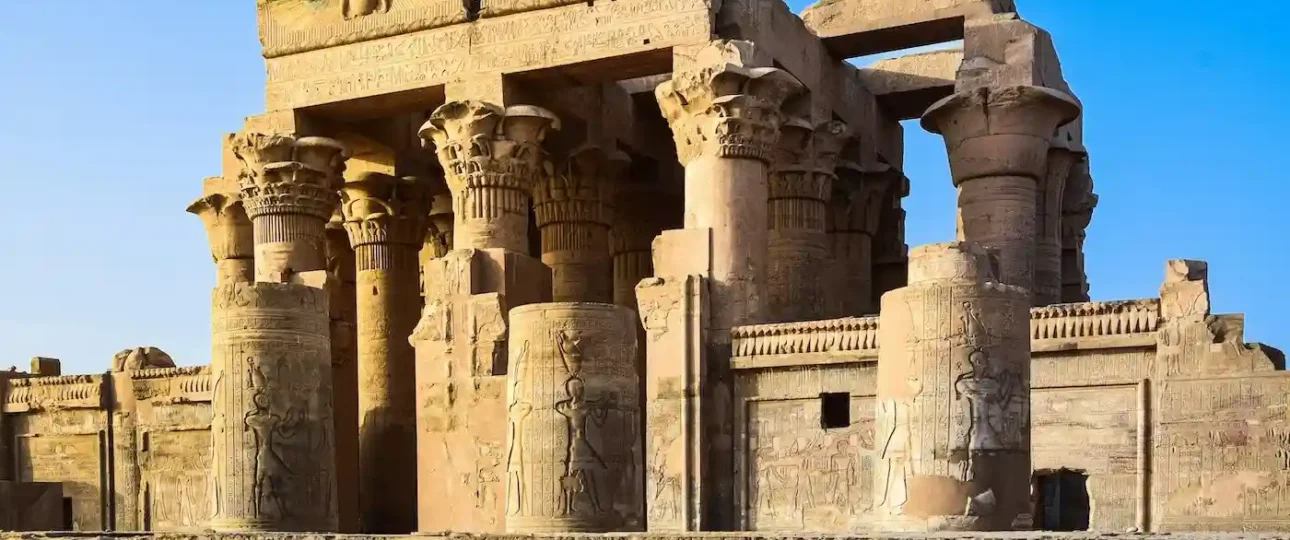Temple of Kom Ombo: Unveiling the Dual Sanctum of Ancient Egypt
Introduction
Perched dramatically on the banks of the Nile River, the Temple of Kom Ombo stands as a unique marvel among Egypt’s ancient monuments. This double temple, dedicated to two deities – Sobek, the crocodile god, and Horus, the falcon-headed god – offers an intriguing glimpse into the duality of ancient Egyptian religious beliefs. In this article, we embark on a journey to explore the wonders of the Temple of Kom Ombo, delving into its historical context, architectural features, religious significance, and the enduring allure that attracts visitors from around the world.
Historical Context of the Temple of Kom Ombo
The Temple of Kom Ombo was built during the Ptolemaic dynasty, with construction commencing in the 2nd century BC and continuing into the Roman era. It was strategically positioned along the Nile, serving as a prominent religious site and trading hub.
The Dual Sanctum: Sobek and Horus
What sets the Temple of Kom Ombo apart from other ancient Egyptian temples is its dedication to two deities. The northern part of the temple was devoted to Horus, the falcon-headed god associated with the pharaohs, while the southern part honored Sobek, the crocodile god, symbolizing power, fertility, and protection.
The Sacred Crocodiles
Within the temple complex, crocodiles were revered as living embodiments of Sobek. Ancient Egyptians kept sacred crocodiles in specially designed pools as a mark of veneration and sought their blessings for prosperity and protection.
Architectural Features of the Temple of Kom Ombo The design of the Temple of Kom Ombo reflects the unique dual nature of its dedication, with each section carefully aligned to honor the respective gods.
Symmetrical Layout: A Harmony of Beliefs
The temple exhibits symmetrical architecture, with two parallel entrances and a central hall that divides the two sanctuaries. This layout emphasizes the duality and balance between Sobek and Horus worship.
Relief Carvings and Hieroglyphs: Tales of Divine Encounters
The temple’s walls are adorned with exquisite relief carvings and hieroglyphs that depict religious rituals, offerings to the gods, and mythological tales of divine encounters. These artistic features offer valuable insights into the religious practices and beliefs of ancient Egypt.
Religious Significance of the Temple of Kom Ombo The dual dedication of the Temple of Kom Ombo signifies the ancient Egyptians’ belief in the complementary and harmonious coexistence of deities.
Sobek: The Crocodile God
Sobek was revered as the god of fertility and protection, often associated with the Nile’s life-giving waters. Worshippers sought his blessings for agricultural prosperity and safeguarding against dangers.
Horus: The Falcon-Headed God
Horus, the divine protector of the pharaohs, symbolized kingship and divine authority. The temple’s dedication to Horus emphasized the site’s association with the reigning pharaoh and his divine role as the earthly representative of the gods.
Modern-day Significance and Preservation The Temple of Kom Ombo remains an enduring testament to ancient Egyptian beliefs and architectural ingenuity, drawing visitors and researchers to unravel its mysteries.
Cultural and Touristic Attraction
As a significant cultural and touristic attraction, the Temple of Kom Ombo is also a highlight for travelers enjoying a Nile Cruise, since most cruise itineraries between Luxor and Aswan include a stop at this remarkable temple
Preservation Efforts
Efforts by the Egyptian authorities and international organizations ensure the preservation and conservation of the temple, safeguarding its artistic and historical legacy for future generations.
Conclusion
The Temple of Kom Ombo, with its dual sanctuaries honoring Sobek and Horus, offers a fascinating insight into the religious beliefs and architectural achievements of ancient Egypt. As we explore the symmetrical layout, intricate carvings, and rich symbolism of this extraordinary temple, we are transported back in time, bearing witness to the profound duality and harmony that defined ancient Egyptian spirituality.
NileTravel Machine invites you to embark on this captivating journey to the Temple of Kom Ombo, where history and divine veneration intertwine, inviting us to uncover the mysteries of Egypt’s past and embrace the enduring allure of one of humanity’s most extraordinary ancient wonders
If you are fascinated by the wonders of Kom Ombo, don’t miss exploring another masterpiece of ancient Egypt — the Luxor Temple, a site that beautifully reflects the grandeur of pharaonic architecture and religious devotion.

